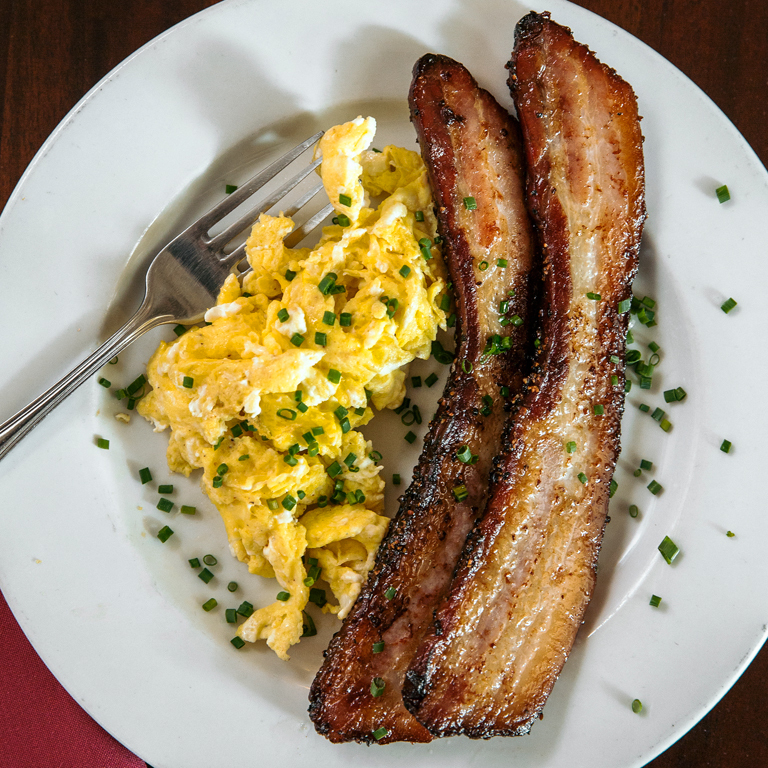Homemade Bacon

Photo: Thomas J. Story
Making the bacon is a three-step process: Cure, smoke, and roast. To light the small amount of charcoal required, you'll need inexpensive paraffin lighter cubes, available wherever barbecue supplies are sold. You'll also need wood chunks 2 to 4 inches wide. "They give off a little more smoke than chips and last longer," says Lettau. He uses fragrant California red oak chunks (find at fruitawoodchunks.com), but easy-to-find hickory, apple, and cherry make good-tasting bacon too. If you would like to use curing salt, see "What About Nitrite?" (below). For directions for smoking bacon on a gas grill, see sunset.com/bacon-gas-grill. Total time: 6 to 8 days
How to Make It
Mix together salt (and curing salt, if using) and sugars in a bowl with your hands. "That way you can break up the lumps in the brown sugar." Rinse pork belly, pat dry, and cut in half crosswise (with the grain).
Rub pork halves all over with molasses. "Get it into all the nooks and crannies. When it's nice and lathered up, sprinkle both sides with pepper." Follow the pepper with a generous sprinkling of salt-sugar mixture; depending on the size of your halves, you may have quite a bit left over. "Massage it in gently all over and then give them a little shake" to get rid of the excess.
Put each half in a nonmetallic container with 2-in.-high sides, such as a Pyrex baking dish. Cover with plastic wrap.
Chill pork halves 5 days to 1 week, depending on their weight. Turn them over every day. They will produce quite a bit of liquid, which you should leave in. "You have to turn them religiously. That gets them to cure evenly." They will feel firmer than they did when raw and will be a deep rosy brown color (rosier if using curing salt).
Rinse pork (it's okay if some pepper still sticks) and pat dry. "Otherwise your bacon might be too salty."
Meanwhile, stack 4 or 5 charcoal briquets and a couple of paraffin lighter cubes to one side in a chimney starter, ignite cubes, and let briquets burn until ashy and glowing, about 20 minutes.
Set an 8- by 10-in. disposable aluminum roasting pan on one side of grill's firegrate. Arrange 4 or 5 wood chunks in pan in a single layer. With tongs, set the ashy briquets directly on chunks, spaced apart.
When chunks begin to smolder, open bottom vents of grill and set cooking grate in place with hinged section over wood. Lay pork halves, fat side up, on cooking grate but not directly over wood. Set lid in place and fully open its vents. Your goal is to produce lots of billowing smoke.
Keeping the heat between 150° and 200°, smoke pork 3 1/2 hours. Check the heat every 20 minutes or so. If it dips below 150°, add another chunk and/or ashy briquet to the pan. If it climbs above 200°, close top and bottom vents halfway, or remove a chunk or briquet.
Chill smoked bacon, uncovered, 4 hours, then wrap well in plastic wrap and chill overnight. "You want it to be not so pliable when you cut it."
If the bacon's sides are uneven, "whack them off and use them in soup or beans. At the restaurant, we dice them up and make bacon jam too. I put that on everything!" Set a metal rack in a rimmed baking pan; repeat with a second pan and rack. Slice bacon with the grain about 1/2 in. thick, then lay slices on racks.
Put pans in oven and turn to 425° (do not preheat oven). Roast bacon just until edges are crisp, about 30 minutes, rotating pans halfway through if necessary for even browning. "I like to render it first so some of the fat drips out, but not so much that you get shrinkage." Bacon can be cooled at this point, then wrapped in plastic wrap and chilled for up to 2 days.
To finish cooking, either grill it (as Lettau does at the restaurant), pan-fry it, or keep roasting until it's as crisp as you like. Lettau suggests not overcooking. "I like the edges to be crisp but the rest juicy."
*Diamond Crystal is more voluminous than Morton's, so you need to use more of it for equivalent saltiness.
Make ahead: Smoked bacon (through step 9), up to 1 day, wrapped in plastic wrap and chilled; or up to 2 months, frozen. Rendered bacon slices (through step 12), up to 2 days, wrapped in plastic wrap and chilled.
What about nitrite?
Brad Lettau cures his bacon without sodium nitrite, a salt used commercially to ward off bacteria. (Sodium nitrate, also sometimes used, converts to nitrite in the body.) Bacon made without nitrite tastes porkier and is browner; nitrite is what adds that familiar "bacon-y" taste and rosy hue.
Lettau's bacon is absolutely safe to make at home because it's roasted well. But if you're considering using sodium nitrite, here's what to know. In the 1970s, studies suggested it could be carcinogenic; however, the National Academy of Sciences and the American Medical Association have since concluded that, in the small amounts typically added to food, it isn't harmful. In fact, we get nitrite from vegetables (especially celery and spinach).
If you opt to add sodium nitrite to Lettau's recipe, all that's required is 1 teaspoon of pink curing salt (a mix of 25 percent sodium nitrite and 75 percent salt) for every 5 pounds of meat, mixed in with the dry rub in step The bright pink color means you won't mistake it for table salt. Find it on amazon.com.

